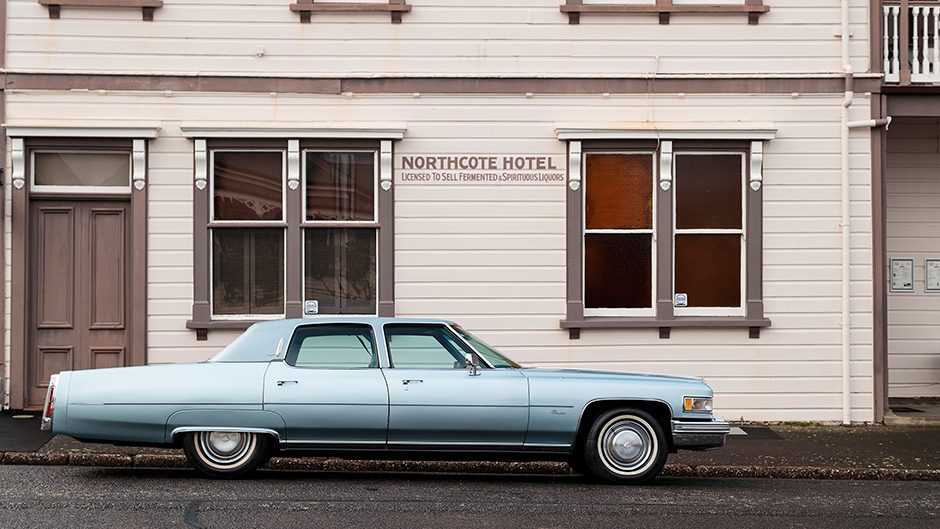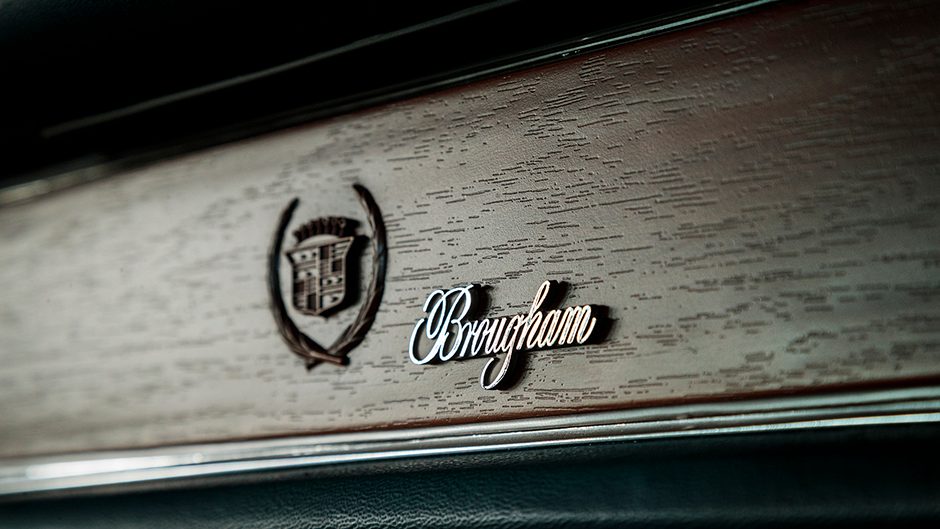1975 Cadillac Sixty Special Fleetwood Brougham
Words Kyle Cassidy | Photos Tom Gasnier
Cadillac is america’s undisputed king of luxury, with a continuous history of producing automobiles dating back to 1902. And in 1975, the fleetwood brougham was the epitome of comfort and extravagance.
Cadillacs from the mid-1970s were many things, but were mainly very big and rather square as you’ll see from our subject here, a 1975 Sixty Special Fleetwood Brougham. The Sixty Special model line originated in the 1930s and by the mid-seventies was in its tenth generation. Over four decades, the styling evolved from big flowing front fender guards in the 30s and 40s, to the excesses of chrome, curves, fins and bumper bullets in the 50s.
The styling flamboyancy was toned down in the 60s when the fins got smaller while the overall proportions grew wider. By the 70s, the curves were well squared off and the cars were simply massive. The tenth generation was the last of the truly gigantic Cadillac line, its replacement in 1977 being smaller all round, following the success of the newly introduced Seville in 1975. This was a more compact offering to fight the influence of the European luxury cars.

However, we digress, and here we delve into the fulsomeness of the Fleetwood Brougham. The line-up in 1975 included the entry-level Calais Coupe and Sedan, while of the 185,000 Cadillacs sold that year, the de Ville line proved the most popular.
The firm made 18,755 Fleetwood Broughams and while that was a big sedan at 5936mm long, they made them even longer with the Seventy Five measuring over 6.4m in length. Cadillac still produced the commercial chassis for use as ambulances and hearses and the like, and also had the front-drive Eldorado sitting on the E-body platform. For ‘75, the American made the 500CID (8.2L) V8 standard across the range.
Fitted with a new-fangled catalytic converter, tuned to run on unleaded gas and breathing through a Rochester Quadrajet 4MV with an electric choke, it made a staggering 190hp (141kW) with 488Nm of torque. GM’s High Energy Ignition System was also now standard which eliminated the points and condenser for added reliability. A bigger radiator stopped it overheating in traffic and new engine mounts made for a smoother ride.

The V8 hooked up to the three-speed Turbo Hydra-Matic which gained an improved torque converter for 1975, while Cadillac lowered the axle ratio to 2.73:1 and developed steel-belted radial ply tires with lower rolling resistance to help improve economy, which was still horrendous at 9mpg, or 24L/100km. The Fleetwood retained its body-on-frame construction, called the rigid perimeter frame, the front suspended via upper and lower control arms with helical coil springs. The four-link solid rear axle came with a self-leveling system.
Performance was mild, not helped by the near 2400kg weight, with 0-60mph taking the better part of 12 seconds.
Though the Fleetwood Brougham was a high spec model there were still a raft of options available, including fuel injection for the V8, dusk-sensing lights and the recirculating ball steering system could be had with a variable ratio. An early form of ABS was available too, the Track Master ‘computer-controlled’ rear-wheel braking system pumped the brakes to maintain rear wheel rotation.

It probably would have been more use on the front end to help maintain steering control. Another safety option which was introduced in 1974 was an Air Cushion Restraint system for the driver and front passenger, which proved unpopular and was dropped in 1976. While white wall tyres were standard, you could option a wider stripe too. The Brougham featured climate air con, the system maintaining the selected temperature using ‘hidden sensors’ and featured a ‘space age’ instrument panel design, including a ‘digital’ clock.
A signal-seeking AM/FM radio with power antenna was standard (eight-track being an option) as were power windows and door locks, a padded Elk Grain vinyl roof with coach lamps, tinted glass and the Dual Comfort front seat with driver’s six-way power adjustment. This example is a bit of a survivor, imported from Texas with just over 12,000 miles on the clock. It’s in as-original condition, with just a few blemishes about the place for its 42 years, but thankfully no rust.
Complementing the gargantuan length is a width of 2027mm, and a wheelbase stretching 3378mm. They deliver ample proportions for the interior, which is a mix of 70s kitsch, comfort and luxury. Take the seats, for instance, which are more akin to couches and clad in the most outrageous Monticello velour trim.

It’s a genuine six seater, the front bench powered, while the rear is outfitted with foot rests and reading lamps. The drive is accentuated by the ease of everything; the over-assisted steering, the lazy torque of the V8 and the gelatin ride. It handles best at the straight ahead, designed as it was to slink along boulevards and cruise freeways and turnpikes.
This rides like it’s suspended on pillows, though the body-on-frame construction means the bumps wobble their way through the cabin. The V8 is smooth and utterly unstressed while the auto shifts in true slushbox fashion, the second to third swap almost imperceptible.

The Fleetwood has some natty features, like the outside temperature gauge on the wing mirror and the remote adjuster for the right side mirror sighted just next to the steering wheel, itself featuring telescopic adjustment.
And this big Caddy manages to crane as many necks of onlookers as the $300k i8 Roadster we drove this month.
On that scale, the $30k asked for this example, for sale at Bunce Motors in Auckland, makes it seem like a bargain. It also leaves plenty of money left over to fill that 102 litre fuel tank.

















